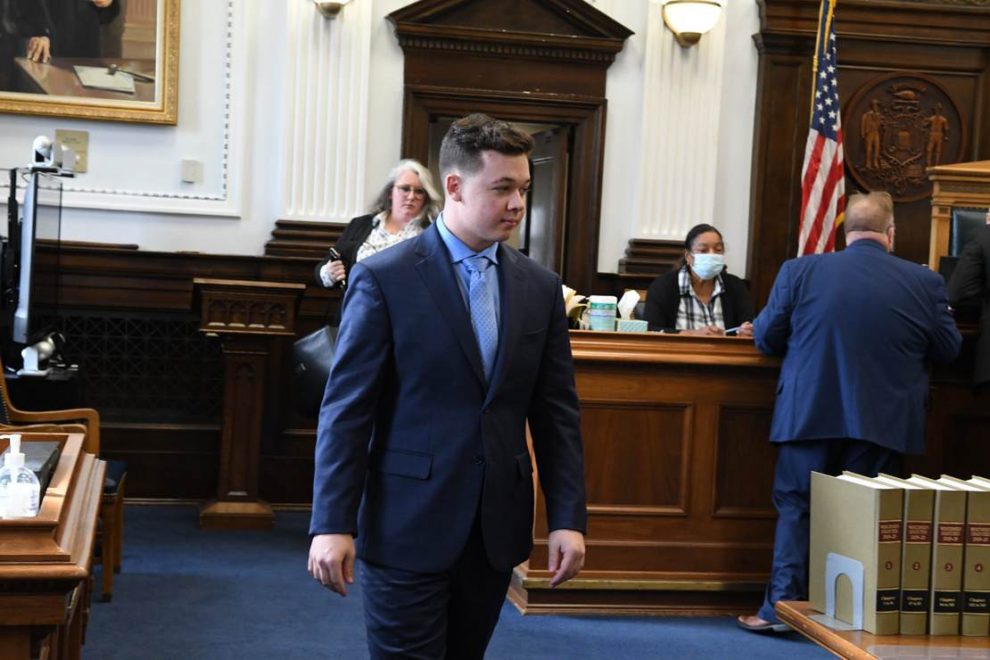On August 25, 2020, Kyle Rittenhouse defended his life against three attackers at an Antifa and BLM riot to stay out of a box in the ground. Now, the 18-year-old finds himself fighting for his life in a Kenosha courtroom to keep from spending the rest of his life in a cage.
The legal fight to convince a jury that it was reasonable to use his gun to save himself is winding down. On Thursday, the defense rested its case in the nearly two-week trial that saw moments of high drama and open prosecutorial misconduct. Indeed, that the case was bought at all appears to have been more a function of woke politics than the search for justice, as the prosecutor alluded to on Thursday. That it hasn’t been declared a mistrial may prove to be an even bigger injustice.
This week, Rittenhouse undertook the second riskiest thing he’d ever done in his short life: He subjected himself to hours of questioning by the man trying to put him in prison. He didn’t have to testify.
It’s been clear from all available video evidence for more than a year that the 17-year-old Rittenhouse defended himself from men who attacked him during the riot. More than five men attacked him that night, and a mob chased him with pipes, poles, and at least one gun. Rittenhouse fired his gun eight times that night. Two of his attackers died and another protester, Gaige Grosskreutz, was wounded when he leveled his hand gun at Rittenhouse’s head from three feet away. Not even the New York Times denies self-defense.
The life guard and police cadet answered the call with several others to help secure a business in Kenosha on the third night of the riots, which saw the police retreat, looters plunder, multiple gunshots fired, and arsonists incinerate. Rioters destroyed the Department of Corrections building and torched more than 100 businesses, causing millions of dollars in damage.
He protected his community when no one else would pic.twitter.com/3TEjRRGYzW
— Alex Sheppard 🇺🇸 (@NotAlexSheppard) November 11, 2021
Government offices were boarded up and mayhem ruled the streets. Indeed, at one point Kenosha cops thanked the band of armed guards who came to secure the Car Source business.
Rittenhouse, who had first aid training, came as a medic, protector, and helper. He traveled to town earlier in the day to help clean riot graffiti from downtown and came back with friends after dark, toting his long gun to protect himself and the Car Source business from further destruction. Two of the company’s locations had been destroyed by rioters.
A group of armed individuals stands guard outside this gas station again tonight. They’ve been cooperative with the crowd as they come through, asking that they simply don’t destroy this property or loot #Kenosha #KenoshaProtests pic.twitter.com/mBShiUe0uD
— Brendan Gutenschwager (@BGOnTheScene) August 26, 2020
Shortly before midnight, Rittenhouse was confronted by a crazed, out-of-control man who, testimony showed, had to be routinely constrained. Testimony showed the older man threatened Rittenhouse, saying he’d “cut his heart out.” He told Rittenhouse and a buddy that “if I catch you alone I’ll kill you.”
Unknown to Rittenhouse at the time, that man, Joseph Rosenbaum, was a convicted child rapist who abused boys. He had a long record of domestic violence and had been released from a hospital hours before after receiving treatment for bipolar issues.
He chased Rittenhouse into a car lot with another man, Joshua Ziminksi. Testimony and FBI spy video at trial showed that Rosenbaum ducked behind a car and lay in wait for Rittenhouse. Ziminiski, who followed behind, fired his weapon in the air, elevating Rittenhouse’s fear. Rosenbaum chased and lunged at Rittenhouse.
A mere 2.5 seconds after Ziminski’s gunshot, Rosenbaum boxed in Rittenhouse among a bunch of cars and the shooting started. Rittenhouse testified that the older man lunged and then grabbed for his Smith and Wesson M&P rifle and he fired four times. The medical examiner found specific residue on the attacker’s hands. The prosecutor claimed Rittenhouse shot Rosenbaum in the back, but the M.E. testified that the attacker’s four wounds were consistent with a man who was shot in quick succession. Indeed, the elapsed time between the shots was 2.933 seconds, barely time to think or blink.
Ziminski, a protester, brought his pistol to the riot and was charged with arson and disorderly conduct. His wife was also charged. Though testimony and video showed that Ziminski fired the weapon, there was no testimony about how many shots he fired that night. Ziminski reported the gun stolen in the hours following the riot. Ziminski was never called to testify.
After the shooting, Ziminski and his wife screamed for the mob to kill Rittenhouse and “cranium” him.
Our colleague, Julio Rosas, was there as Kyle Rittenhouse ran away from a mob urging people to kill him after the shooting. It was there that Rittenhouse confronted more attacks from the mob.
A tire fire has been started in the parking lot of a car dealership in Kenosha. pic.twitter.com/UCVQZUFguo
— Julio Rosas (@Julio_Rosas11) August 26, 2020
As the mob chasing Rittenhouse moved in, on person hit him in the head from behind and he lost his footing and fell to the pavement. As he lay on the ground, a man wearing work boots launched himself in the air and kicked Rittenhouse in the face. Rittenhouse fired two rounds and missed the man.
After more than a year, Kenosha police have never identified that man to question him or charge him with assault and battery on Rittenhouse.
As Rittenhouse lay on the ground, 26-year-old Anthony Huber used his skateboard to bash in his head and neck. Huber reached for Rittenhouse’s gun and then grabbed the strap. Rittenhouse shot him.
Rittenhouse testified that a man with a pipe or some long object and what looked to be a post were on his right and his left. It was then that 26-year-old protest regular Gaige Grosskreutz ran up on the scene. Grosskreutz pulled his concealed pistol and testified that Rittenhouse shot him only after he pointed his pistol at him. Unlike Rittenhouse, Grosskreutz was never charged with breaking curfew or gun crimes. Grosskreutz carried an unlicensed concealed carry weapon and lied to police about drawing it before he was shot. He lied to police about it and didn’t mention his complicity while trying to get a $10 million settlement from the city.
Grosskreutz testified that Rittenhouse re-racked or cleared his weapon before he took the shot, but there was no evidence supporting his claim, no eyewitnesses, and no physical evidence to support it. A Kenosha police officer and evidence collector testified that there was no unspent brass found at the scene.
The prosecution also asserted in Thursday’s testimony that a fuzzy photo shows Rittenhouse pointing his gun at Ziminski before the attack by Rosenbaum. Rittenhouse testified that his rifle was at low ready until he raised it to shoot him.
As attorney Andrew Branca writes over at Legal Insurrection, the photo is worse than fuzzy. Defense attorneys attempted to keep out the photo, but the judge, squinting at the photo, let it in.
The photo appears to be far more manipulated than represented in court.
It’s worth keeping in mind that other than these images, there is literally zero evidence in this trial that is inconsistent with Kyle’s claim of self-defense. So to believe that legal defense disproven beyond a reasonable doubt, these images are all one has on which to base such a belief.
Perhaps you see that disproof of self-defense beyond a reasonable doubt in those images—I certainly do not.
To believe the State’s representation of these images, you would also have to believe that right-handed Kyle suddenly decided to hold that rifle in a left-handed manner, with the buttstock in his left shoulder and the muzzle raised upward.
Instead, it’s far more likely that the right-handed Kyle was holding the rifle in a right-handed manner, with the buttstock in his right shoulder and the muzzle pointed down.
He wasn’t the only one who thought there was more going on than pixel shifting and coloring.
If this shows Kyle Rittenhouse holding the rifle, how did he suddenly become left-handed?
They can do anything with computers now! pic.twitter.com/W2m66tVvsK
— Jack Posobiec 🇺🇸 (@JackPosobiec) November 11, 2021
When he testified, Rittenhouse said that he shot rather than give up his gun to Rosenbaum and Huber to have them kill him or others with it.
Use-of-force attorney Branca, mentioned above, has provided invaluable blow-by-blow of this trial. He says that it’s a clear-cut, text-book case of self-defense and that Rittenhouse’s actions in that short span of time in August of 2020 meet every legal test for self-defense.
I’ve outlined on PJ Media those based on Branca’s guide.
Here’s how self-defense works.
If a person is in reasonable fear for his life or great bodily injury, in which he is not the initiator of the violence, he can claim self-defense.
Andrew Branca, a use-of-force lawyer who runs the Law of Self Defense website, says there are five key elements in self-defense:
1. Innocence: You can’t have started the fight.
2. Imminence: You are in imminent danger of great bodily injury or death.
3. P roportionality: Use deadly force if you are confronted with deadly force.
4. Reasonableness: Were you reasonable in your reaction?
5. Avoidance: Run away if possible before using deadly force.
The jury will get the case on Monday. Pray for justice to be served.
Story cited here.
























